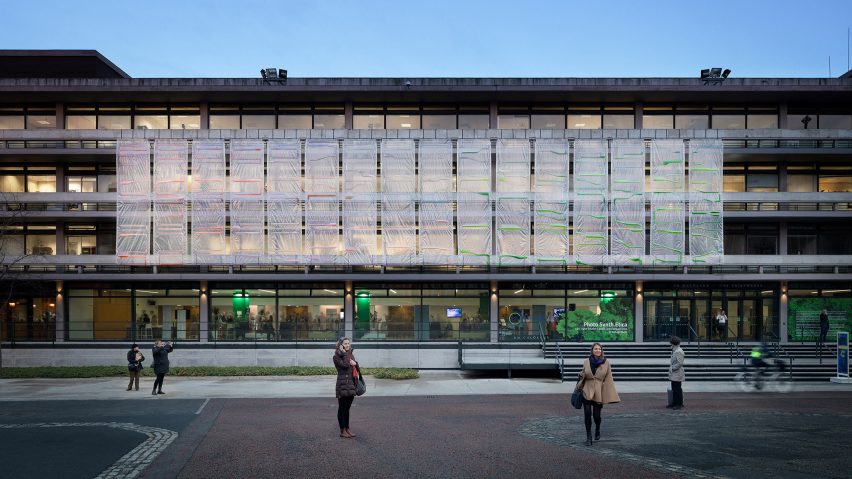London-based architecture office EcoLogicStudio harnesses photosynthesis in algae to remove air pollution with this living curtain, designed to rest over building facades.
The studio's Photo.Synth.Etica "urban curtain" is a photobioreactor – an incubator for algae, which carries out the naturally carbon-sequestering process of photosynthesis.
The micro-algae feeds on daylight and air, capturing carbon dioxide molecules and storing them within the curtain, while producing oxygen and releasing it back into the surrounding air.
The curtain optimises this natural process, capturing approximately one kilogram of carbon dioxide per day — the equivalent to that of 20 large trees.
EcoLogicStudio envisages the curtain being integrated into new and existing buildings, and doubling as a sunshade.
The Photo.Synth.Etica prototype is made of 16 bioplastic modules, each measuring two by seven metres. The serpentine tubes embedded into the panels optimise the carbon sequestration process, according to the architects.
Unfiltered air enters the curtain from the bottom, and as it travels up through the liquid in the tubes, the micro-algae within captures the carbon dioxide molecules. This process of photosynthesis also produces oxygen, which is released from the top of the unit.
Another beneficial byproduct of the process is biomass, which the algae grows from the sequestered carbon, and which can be burnt for energy or turned into bioplastic material, such as that used to make the curtain. The algae is also bioluminescent, casting a faint glow at night.
The team EcoLogicStudio says the pattern in the curtain reminds them of "trading data charts" — an appropriate metaphor given that the project was produced in collaboration with European Union climate innovation initiative Climate-KIC, which promotes sustainable production models.
"The message is one of spatial convergence and connectivity between the financial marketplace of cyberspace and the relative organic molecular transactions in the biosphere," said EcoLogicStudio.
The architects displayed a prototype of the system during the Climate Innovation Summit 2018 in Dublin at the start of November. The installation was stretched over floors one and two of the main facade of the Printworks building at Dublin Castle.
"Smart cities, smart homes, autonomous vehicles, robotic factories, etcetera dominate the current panorama of popular futuristic scenarios, but they all desperately need spatial and architectural re-framing to engender beneficial societal transitions," said EcoLogicStudio.
"Photo.Synth.Etica suggests that, in the anthropocene age, a non-anthropocentric mode of reasoning, and deploying cutting-edge technologies based on digital and biological intelligence, could be at the core of urban design and stimulate our collective sensibility to recognise patterns of reasoning across disciplines, materialities and technological regimes."
As with previous projects by EcoLogicStudio, the curtain is a form of biomimicry — a design that copies structures and processes from nature.
The studio, which is led by architects Claudia Pasquero and Marco Poletto, was also behind the Urban Algae Canopy pavilion at the 2015 Milan Expo. They have also founded the Photo.synthetica consortium to engineer more of these kinds of solutions.
Carbon sequestration was broadly endorsed by the United Nations' Intergovernmental Panel on Climate Change, which in its latest report in October, incorporated this form of geoengineering into most of its safe pathways for dealing with global warming.
Designers such as Nicolas Roope responded to the UN report, by calling the need to avert climate change "the greatest design challenge in history".

